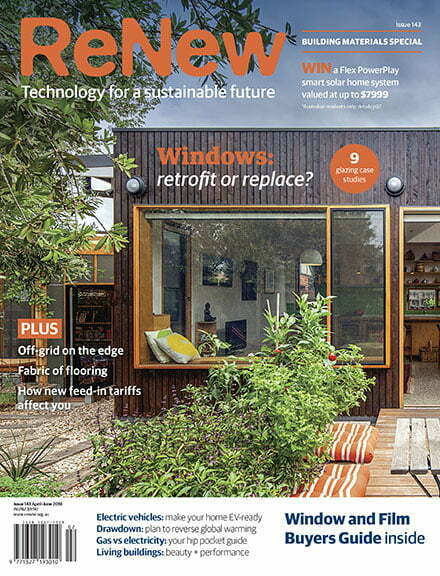Windows that perform: A window and film buyers guide
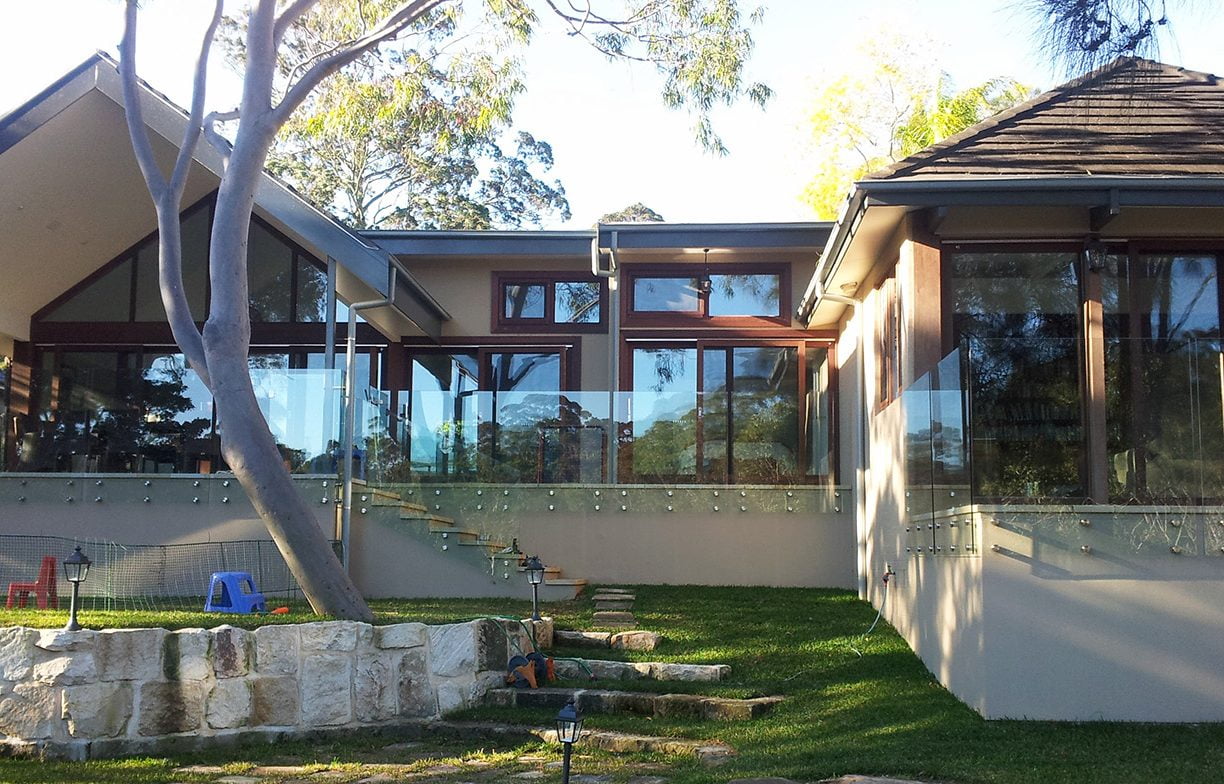
Poorly performing windows can drag down the thermal performance of your home. Lance Turner looks at some solutions.
This article was first published in Issue 143 (Apr-June 2018) of Renew magazine.
Reducing heat flows through windows and doors is critical for maintaining a comfortable temperature during weather extremes. Heat flowing through an unprotected single-pane window can be considerable, affecting the thermal performance of an otherwise well-insulated house. In fact, a single-pane plain glass window has almost no insulating ability—around R0.2.
The Australian Window Association (AWA) estimates up to 40% of a home’s heating energy can be lost through windows and up to 87% of its heat gained through them. Choosing high-performance windows, combined with sensible window placement, insulating blinds and other window improvement methods such as special films and coatings, can reduce energy costs and improve thermal comfort. Understanding how different windows interact with the design of your home can be key in window selection.
Heat transfer
There are three main ways heat transfers through windows: radiation, conduction and air infiltration.
Firstly, heat is lost by indirect radiation. Warm objects inside the room radiate heat at long wavelengths (between 5 and 40 micrometres). This energy cannot pass directly through plain glass as it is opaque to such long-wavelength radiation. However, some radiant energy is absorbed by the glass and this is conducted through the glass to the outside. In summer, the reverse occurs, with long-wavelength radiant heat (radiated by hot air and hot surfaces outside) passing indirectly through the glass into the room.
Still greater is the transmission of radiant short-wavelength solar energy—consisting of visible sunlight plus near-infrared radiation—which is largely transmitted directly through clear glass.
Secondly, heat is lost through conduction—direct transfer of heat from the warm side of the window to the cool side. In aluminium frames with no thermal break, heat is conducted up to six times more readily through the frame than the glass, as aluminium is such a good heat conductor.
In winter, conduction from inside to outside also drives a convection current on the inside of the window, accelerating the rate of heat loss. Warm indoor air cools when it comes in contact with cold glass and falls to the floor, drawing in more warm air from above. This heat loss method can remove a great deal of heat from a room.
If your heating system has outlets directly under or above the windows, this will increase heat loss by increasing the temperature differential at the glass and breaking up the air layer on the inside of the window (although deflecting the warm air away from the window will help).
A final method of heat transfer is air infiltration. This occurs when air leaks through the gaps between the inner frame (that holds the glass) and the outer frame (head, jambs and sill). Poorly sealed windows result in a high air infiltration rate and poor thermal efficiency due to the transfer of warm air. This is particularly an issue in areas that see higher winds.
But by far the main problem with heat loss through windows is plain glass. Standard unshaded single-pane, untreated glass windows are an energy efficiency disaster, but there are lots of alternatives. These include double and triple glazing, factory-applied glass coatings, add-on (secondary) glazing systems, stick-on window films and a myriad of window coverings.
But how do you know which glazing system or treatment is the best solution for you? It’s a complex task for the average homeowner, so here we look at window performance measures and the types of glazing you can choose from.
Window performance measures
Arguably the most important window performance factor is the whole-window U-value (Uw), which measures how readily a window conducts heat. The lower the U-value, the greater a window’s resistance to conductive heat flow and the better its insulating value.
Note that it’s a ‘whole-window’ measure: all window performance measures in Australia include the effect of the frame and edge of the glass as well as the main central glass area.
Real-world U-values range from about 8 (worst case, single-pane glass) down to 1 (best case). In almost all cases, a low window U-value is better in all climates.
You’ll sometimes hear that a high U-value is better in hot climates because this allows the home to cool down faster at night. Other things being equal, this might seem true. However, cooling by means of night-time ventilation through open windows will flush out the day’s accumulated heat at a rate many times faster than conduction through closed windows.
Windows with a low U-value also have a surface temperature on the inside that is closer to the desired room air temperature. This is true in all seasons and means better thermal comfort for people near the window.
U-value is the inverse of R-value, the window’s resistance to heat flows. So for the range mentioned above of U-values from 8 down to 1, the equivalent R-value is 0.125 to 1. However, most windows never achieve a U-value much lower than 2, which equates to an R-value of 0.5. Compare that to the R-value of a well-insulated wall of around 2.5. This demonstrates the importance of additional measures, such as the use of insulated window coverings, which we look at later in this guide.
The other important factor influencing window performance is its whole-window solar heat gain coefficient (SHGCw). This measures the window’s ability to control heat transfer from solar radiation (short and re-radiated long wavelength). It is the amount of solar radiation admitted through the glass and frame combined (both directly, and absorbed and re-transmitted) as a fraction of the total solar radiation falling on the outside of the window. The coefficient is expressed as a number between 0 and 1—the lower the number, the less solar heat the window transmits.
Real-world SHGCs range from about 0.75 down to 0.15. Unlike U-value, we don’t tend to label high SHGC as ‘bad’ and low SHGC as ‘good’ as the judgement depends on the climate where the building is located.
Improving your window performance
So what are your glazing choices to achieve high performance?
Double or triple glazing
Energy-efficient windows are invariably multi-pane types—double or triple glazing—as single glass panes have a very high U-value (this can be improved to an extent with special coatings; see next section).
These multi-pane windows consist of two or three panes of glass separated by a small gap, in the range of 5 to 20 mm per gap. The gap may be filled with air, or a gas like argon which has slightly better insulating properties. Because the airspace is narrow there is not enough room for convection currents to circulate, so the layer of gas between the sheets of glass acts as an insulator, much like the tiny pockets of trapped air in bulk-fill insulation.
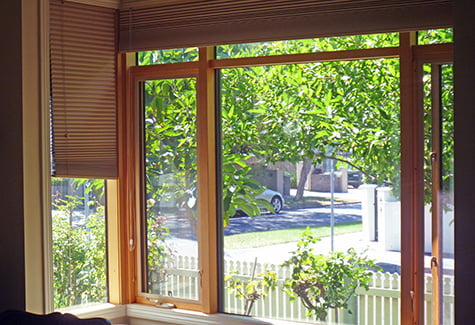
Double and triple glazing is generally made as a unit which is a complete set of glass panes, sealed together with edge sealing and the appropriate gas already present between the panes. They are treated like a single pane, with the only difference being that the window frame will obviously need to be deeper to accommodate the much greater thickness of the unit, and they can’t be cut so must be made to exact size at the factory.
Multi-pane windows are far superior to single-glazed windows for insulating your home. If you’re wondering whether the added cost of improved glazing is worthwhile, consider that compared to single glazing, a double-glazed window could cut your heat loss in half. Payback will depend on the cost of the glazing and your heating/cooling needs; retrofit double glazing will have a longer payback time than using it in new builds, as you’re paying to replace existing windows rather than just the additional cost of double over single glazing. But many people are happy to wear that for the increase in comfort (see case studies elsewhere in ReNew 143).
Multi-pane glazing can be particularly useful in cold and mixed climates as it will retain more warmth after sundown, reducing heating loads. In such climates, a glazing unit with high SHGC will preserve passive solar gain. Even on the north side of a home, on a seasonal basis, low-U, high-SHGC glazing will easily outperform clear single glazing. Even though its solar gains are lower, this is more than offset by reduced heat loss to the outdoors. In net terms you are ahead!
Shading double glazing is even more important than shading single-pane windows, as double glazing will trap solar heat in the home in summer if exposed to the sun. But this doesn’t mean that double glazing shouldn’t be used in warmer climates—it should be used in conjunction with appropriate shading, window coatings or other direct radiant protection. And remember, exhausting heat at the end of the day is as simple as opening a few windows, so window types that can be opened wide, such as double-hung or casement windows, should be given preference.
There are numerous window types, each with their own advantages for particular purposes. Here are the most common types.
Double-hung: These consist of two separate sashes (the moveable part of the window frame that holds the glass panes) which are counterbalanced with concealed weights. Windows open vertically by sliding. Screens are installed outside on the window frame.
Sliding: These slide open horizontally, and have two or more sashes. Screens are installed outside. Provide good ventilation levels.
Bi-fold: These have two or more window panels that fold up concertina-style, like a bi-fold door.
Louvre: A series of horizontal blades or louvres tilt to open, providing easily adjustable ventilation without compromising security. Blades are often glass, but may be aluminium or timber for privacy. Controlled by a simple handle, or electrically.
Casement: These are hinged at the side and open outwards, much like a regular door. They are often operated by a crank system. Screens are usually on the inside.
Awning: Hinged at the top and open outwards. They are good for wet weather as they allow minimal rain ingress.
Hopper: Similar to an awning window, but hinged at the bottom and open inwards. Similar advantages to an awning window.
Tilt-and-turn: These open inwards in two ways. They can open like a regular casement window, hinged at the side, or like a hopper window, hinged at the bottom. This gives greater versatility.
Sashless: Some designs, such as double-hung and sliding windows, are available in sashless versions, where the glass is not surrounded by a separate sliding frame (the sash). These allow for unbroken views through the window.
The most suitable window depends on the orientation of the window (does it face incoming weather), what it will be used for (ventilation or views), level of security required (windows with limited opening distance can be more secure) and personal preference. For example, high air flows for good ventilation need windows that open fully or quite wide, whereas in other situations, such as windows that receive the brunt of the weather, you want windows that still offer some weather protection even when open, such as louvres or awning windows. If you want to maximise views, then sashless windows would be preferred, assuming they meet the other criteria.
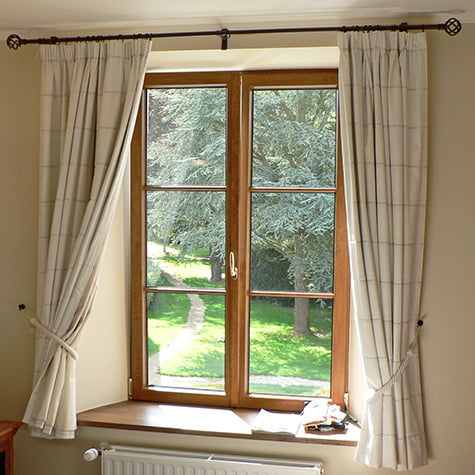

Glass coatings and tints
There’s a lot more to consider than multi-pane glazing, though. Coated or tinted glass can be used to improve the performance of single-pane windows or to turbocharge the performance of double- or triple-glazed units to make them even better.
Low-emissivity, or low-e, coatings are high-performance examples, often used with double glazing. Such coatings, applied at the factory, reduce the amount of long-wavelength radiant heat that the glass can emit from its other side (hence the name), instead reflecting that heat back into the room, or back outside. This includes infrared heat from heaters and people, and re-radiated heat from hot surfaces such as pavers outside. Thus, low-e coatings can be used to keep such heat inside in winter, and exclude it in summer. This improves the U-value of the glass and reduces the solar heat gain coefficient (SHGC).
Low-e coatings can also be tuned to reflect short-wavelength solar heat—the radiation that comes from the sun hitting your windows—to further reduce the SHGC. All low-e coatings will reduce SHGC to some extent, but the exact amount can be tuned for the particular use. For example, in warmer climates, low-e coatings with a low SHGC can be used to minimise heat transmission, particularly in cases where the windows can’t easily be shaded. In cooler climates, low-e glass will usually be specified with as high an SHGC as possible, to give the benefits in U-value while still maximising solar heat gain in winter, for use in passive solar design (the small reduction in SHGC is outweighed by the substantial improvement in U-value). The approach can be tuned for different windows; e.g. unshaded west-facing windows in a cooler climate might still be specified with a lower SHGC.
Another factor to consider with low-e coatings is the visible light transmission rating (VT). All low-e coatings will block more light than clear glass, and low SHGC coatings will block more, but spectrally selective coatings will maintain VT as high as possible; it’s worth considering the VT rating in conjunction with the SHGC rating. Note that low-e coatings also appear slightly tinted, so you may not want low-e and non-low-e windows next to each other. Talk to your designer about this, or have a look at sample windows side-by-side.
It’s general practice to use a coating on just one pane of a double-glazed unit, allowing for finer tuning of the heat flows. Which pane is coated depends on what you are trying to do.
To keep heat inside a room in winter, the low-e coating goes on the inside pane, on the outwards (or gap-facing) side. This placement reflects some heat before it gets to the air gap, and thus reduces heat loss from the home.
In warm climates or for unshaded windows facing east or west, the low-e coating should be on the outer glass pane, on its inside (gap-facing) side. As previously discussed, it should be a low SHGC coating to reduce solar heat gain, so this placement reflects both direct solar and re-radiated heat before they get to the air gap, and thus reduces heat gain into the home. A low-e coating on this surface will still reflect heat from the home back inside the room, so it also has a positive effect in winter.
In the case of low-e coated single glazing, the coating is always on the room-facing surface.
Another option is to use glass tints. Tints add a pigment to the glass which reduces solar heat gain and light transmission. These are commonly used in very warm climates, such as in northern Australia. If using a tint, check the visible light transmission rating to ensure it meets your needs. Also consider the degree to which the tinting makes the windows reflective or opaque, as per your needs.
Choosing your glazing
Selection of the type of glass and coatings for your windows can be a daunting process. There are some general guidelines that apply, depending on your climate zone and the window orientation, but many factors come into play, including the design of your home and the size of the windows.
Careful tuning of window glazing, size and frames based on orientation can help maximise the result, combined with the use of good summer-only external shading and internal curtains or blinds, and pelmets. This is best done in conjunction with a professional window designer, but below are some tips.
When considering your climate zone, in general in a hot climate (zones 1, 2 and 3 on the map below), you want to reduce heat gain to minimise cooling costs; in a cool climate (zones 6, 7 and 8), you want to reduce heat losses to minimise heating costs; and in a mixed climate (zones 4 and 5), you need a balance between the two. To help you select appropriate windows based on your climate zone, the AWA has produced three simple guides which can be downloaded here.
To help your selection process even further, the Australian Window Association has developed the Window Energy Rating Scheme (WERS). WERS simplifies window comparison by rating windows using a star rating system, based on the window’s basic performance measures, U-value and SHGC. Windows receive a rating for both heating and cooling performance.
You can look up a window on the WERS website to see how it performs, or you can search for windows with a particular star rating for heating and/or cooling. In the table that accompanies this guide, we’ve chosen to include companies with windows at the very high-performing end—7 stars or higher for heating or cooling. Windows with a lower rating may suit your needs, so check the tables online at WERS. See box for more on WERS and how the rating is calculated.
Windows in bushfire zones
The Bushfire Attack Level (BAL) rating system has been designed to improve the ability of buildings to withstand a bushfire attack. The BAL has six levels of risk, with increasing construction requirements ranging from ember protection at the low levels to fire-rated construction at the highest. For windows, the requirements range from installing thicker toughened glass to bushfire shutters or bushfire-approved window frames. The material of a window frame can in many cases be mandated for a higher bushfire protection BAL. Australian hardwoods and uPVC meet many requirements at lower BAL levels, but only some timber species (see AS 3959–2009) will meet higher levels. Aluminium and steel frames meet most requirements for bushfire protection, but you will also want to consider thermal performance.
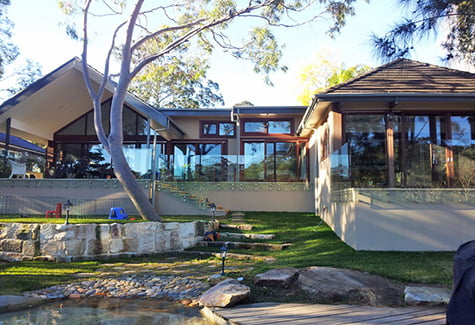
Frames
We must also consider window frames—they are an important part of the heat transfer equation.
The most popular type of frame is all-aluminium, but aluminium is a great conductor of heat and so provides little insulation.
High-performance aluminium frames incorporate a thermal break inside the frame to greatly reduce heat transfer through the frame. This consists of a section of frame between the inner and outer frames that is made from an insulating material such as timber or plastic (usually polyamide).
A number of manufacturers also make ‘composite aluminium’ frames—aluminium frames with timber covering the inside of the frame, effectively creating a thermal break and giving the look of timber windows on the inside and the low maintenance of aluminium on the outside.
Other framing materials available include timber (making sure it is sustainably sourced), uPVC plastic (unplasticised polyvinyl chloride), and even fibre-reinforced plastic (fibreglass), often called pulltruded fibreglass (pulltruding is the manufacturing process).
Materials such as uPVC and fibreglass can be toxic to manufacture (although uPVC has improved in this respect in recent years) and do not readily break down in landfill. uPVC is recyclable and in many countries this happens when homes are deconstructed as it is considered a valuable resource. However, in Australia this rarely happens as PVC recycling is limited and usually restricted to domestic recyclables—we have a long way to go with building material recycling. Aluminium is fully recyclable, but takes a great deal of energy to manufacture initially, although recycling takes just a fraction of the original manufacturing energy.
Another consideration is the longevity of the product. An eco-friendly product may be less so if it needs regular maintenance such as sanding back and painting, and materials with very long lifespans such as aluminium and uPVC may be less of an environmental burden when their lifespan is factored in.
Other ways to improve your windows
Secondary double glazing
Commercially available windows are not the only ways to achieve better window performance. There are a range of aftermarket double-glazing products designed to be attached to the inside of existing window frames as a second layer of glazing material, in effect providing double-glazing performance at a lower cost than complete glass replacement. Some of these are installed by the supplier and some are DIY.
Clear Comfort is a popular DIY option, consisting of a flexible clear film that is held in place with double-sided adhesive tape. The film is then shrunk with a hair dryer to make it taut so that it isn’t noticeable. Although a permanent installation, it can also be fitted to removable ‘fly screen’ frames or homemade frames. Another similar material from Duck also comes in DIY kits.
More rigid add-on products usually use a secondary glazing sheet, often acrylic but sometimes glass, attached to frames that attach to the window frame. This gives performance similar to air gap double-glazing units. Some are easily removable, such as Magnetite, which uses acrylic sheets held in place with magnetic strips that are easily removed for cleaning, and some are semi-permanent, such as ecoGlaze, which uses mouldings to hold the secondary acrylic sheet in place against a spacer to provide the required air gap, although the mouldings are still removable if needed.
There are even systems where the secondary glazing sheet is fitted into an openable frame, making access to the original glass even easier. However, these systems, such as Sound Barrier and Stop Noise, are more aimed at noise reduction and usually have a wider than optimal gap between the glass panes for best thermal efficiency (optimal gap is considered to be between 6 and 16 mm), but they will still improve the window’s thermal insulation.
We’ve even had a reader describe his DIY acrylic add-on glazing in an earlier issue of Renew. We asked him for an update this issue; see elsewhere in Renew 143 for his and other secondary glazing case studies. Also see Renew’s sister magazine Sanctuary for an article on secondary glazing in issue 14.
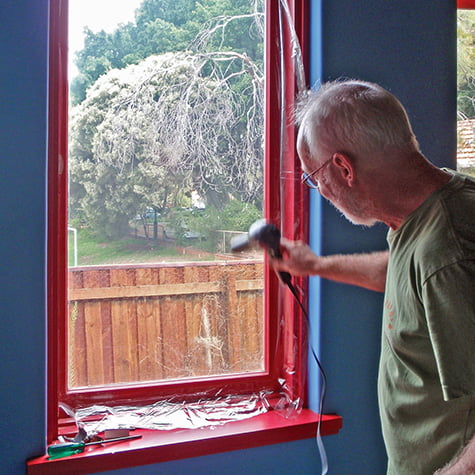
Window films
Another option to improve the performance of your windows is through the application of film. Film can work a lot like a factory-fitted coating on the glass, but instead it comes on a roll for application to existing windows.
Films should be fitted by a professional. While skilled DIYers can install it themselves it should be noted that fitting films cleanly with a professional result takes practice—getting it wrong can result in bubbles, trapped dirt and even glass breakage through thermal stress. Unless you have experience or are willing to live with such potential problems, then it’s recommended that you use a professional window film installer or someone accredited through the WERS For Film program. An accredited installer will issue an energy certificate at the conclusion of the job that can contribute to your home’s energy rating.
Films come in many types, including spectrally selective and low-e. Like glass coatings, films are rated with a U-value and an SHGC, as well as a visible light transmission (VT) rating. These specifications allow you to select the features that you want in a film, just by looking at the numbers, just as you’d do for double glazing and coatings. For instance, if you need to retain good light transmission, then you need a film with a high VT. If you need to exclude direct radiant sun, then you also need a low SHGC.
The film market tends to cater for cooling—keeping the heat out—more so than for keeping the heat in. Low-e films are the only type that reduce the window’s U-value in addition to reducing solar gain and glare. All other films reduce only SHGC and VT (visible transmission) to some extent.
You’ll also want to consider the look of the finished installation. Highly reflective films may be a hazard in some situations, such as sun reflection on busy roads, and may also cause issue to neighbours, so consider such films carefully. And don’t forget that while reflective films may provide privacy in the day time, at night, when the light level inside is higher than outside, the home’s interior is visible.
You also want a film with a long lifespan, so check warranties and look for reviews of your chosen film, or ask the supplier for customer recommendations.
Like windows, there’s a range of films that have been tested and have achieved WERS ratings. WERS film ratings assume the use of poorly-performing (‘default’) frames as there is no way to know the properties of the specific window the film is being used on. This means the ratings are conservative and a real window might perform better than the rating would suggest.
Glass replacements
Yet another option is to replace the glass with a double-glazed unit, retaining the frame. One company that provides this service is Thermawood.
This glass replacement can even be done DIY (though note there are significant risks from handling large, heavy glass units). Check out DIY Double Glaze, a company that takes some of the scariness out of DIY double glazing by providing access to precut secondary glazing panes, double-glazing units and equipment for the DIYer, as well as free advice.
See elsewhere in Renew 143 for some examples of readers who’ve taken this approach. Also see Renew 117 for one reader’s experience installing DIY double glazing, The Australian Window Association (AWA) has pointed out that DIY Double Glaze is not an AWA or WERS member. We recommend you also read the box ‘A warning to DIYers’ before going the DIY route.
Curtains and blinds
If window upgrade options are not suited to your situation—for instance, if you are a renter or your budget is just too tight—then you can improve the thermal performance of windows with insulating window coverings.
Covering windows with thick curtains or using roller or vertical blinds is a good place to start. The curtains/blinds must have pelmets at the top to prevent convective currents circulating between them and the glass, otherwise they will do very little. If you find pelmets not to your taste or impractical, then you may be able to fit a strip of wood or other suitable material between the top of the window frame and the curtain rail or track. (See ReNew 142 for a DIY pelmet suitable for renters.)
Pleated and cellular blinds can seal well because they can be mounted inside the window reveal. Side tracks that seal against air movement are also available, and cellular blinds are available with internal foil layers to reduce heat transfer further. See Renew 140 for more on internal window coverings.
This approach does mean that the windows are only insulated when you can’t see out of them, so you can have a well-insulated house, or enjoy your view, but not both.
To provide both solar control and insulation, insulated external roller shutters are an alternative to curtains or blinds, but when closed, they let in little or no light, so this needs to be considered. Uninsulated metal roller shutters transfer heat through the windows by heating up and re-emitting heat from their inner side, so insulated versions are much more effective. External woven or mesh screens are available which retain some view while providing good solar control. For more on external shading options, see Renew 138.
A new energy rating scheme for window coverings (external and internal) known as WincovER is being developed by the Blind Manufacturers’ Association of Australia (BMAA) and is expected to be launched near the end of 2018. Keep an eye on the BMAA website for updates.
Add-on insulation
There are foil-based add-on window insulation systems available, such as Renshade, which is supplied on a roll and you cut to fit each window, holding it in place with velcro dots. It can also be made into Holland blinds by a blind maker. Another product along those lines is the Inflector insulating panel, a foil mesh panel fitted to a reversible frame, much like a flyscreen. One side is reflective while the other is dark. In summer the reflective side goes outwards, in winter it faces in. The Inflector panels may also qualify for government rebates in some states.
For the budget-restricted or renter, there are some even simpler insulation methods available. One we looked at in Renew 97 is ‘bubble glazing’, which entails the application of a sheet of bubblewrap to the window, holding it in place with double-sided tape. This will impair the view in or out but still let in light, providing a method that is very cheap and quite effective, and adds some privacy as well.
Weather seals
It is also important to remember that a window allowing airflow around it will be a poor insulator, no matter what its materials and construction. Windows that have moving sections should have good seals between the moving frame (sash) and the window frame. Most modern commercially-made windows have a reasonable seal, but their effectiveness depends on how well the window is designed and manufactured. The amount of air that passes through an area of window under a given pressure differential is known as the infiltration rating—the lower the value, the better.
Compression seals, as used on awning and casement windows, usually seal better and last longer than brush seals common on sliding or double-hung windows. High-performance windows with insulated glazing are more likely to have better-quality and better-designed seals, but check this before deciding on a supplier.
A good seal between the window frame and the wall is also very important. When the window frame is fitted, it must be sealed correctly to prevent any air leaks. It is not uncommon to see windows with gaps and considerable air leakage between the frame and the wall, and wall insulation near the window frame may often be disturbed or removed by the window installer—this must be reinstalled or added, if not already there.

Reducing costs
With creative design, you can minimise the cost of energy-efficient glazing. If the windows are not too big, thinner glass can be used, saving cost and weight. Doors have to be glazed with safety glass (which costs more, multiplied by two with double glazing). Windows set down low that are larger than a certain size also must use safety glass. Raising sill heights to 500 mm above floor level can eliminate the requirement for safety glass (as covered by Australian Standard AS 1288) and save a lot of money, yet you may still want to consider safety risks for animals and small children.
With the requirement for all homes to meet energy regulations, efficient glazing is one way you can quickly upgrade a building’s energy performance. Studies by the Australian Glass and Glazing Association on new homes built by one of Victoria’s biggest home builders showed an average cost payback of just over five years. Of course, payback periods will vary depending on the type/amount of heating/cooling and therefore cost of energy used.
Doors
Generally, most of that which applies to windows also applies to doors containing glass, even if the door is only partially glazed. Glass doors are available with many of the same features as windows, including double glazing and the various types of heat flow-reducing coatings. Sealing around doors can be more difficult than windows, but is equally important and should not be overlooked.
Standards and ratings
Windows and sliding doors made to Australian Standards AS 2047 and AS 1288 will carry a certifying label. These standards cover things such as safety, water resistance, air infiltration and other important features. Some windows are fully imported and conform to stringent overseas standards. However, this does not mean they comply to Australian testing requirements. If a window is supplied to you without any certification, you should not use it. Ask about certifications from your supplier before purchasing windows or doors.
Some Australian-made windows don’t need to comply with AS 2047, such as replacement windows for heritage homes.
Windows tested to have a WERS rating will usually come with a WERS label attached. If unsure, check the WERS website for compliance.
Well worth it
Improving the thermal performance of glazing can be expensive, but it is a worthwhile investment, particularly when building a new home. It may be as little as 1% of the total cost of building a home and can reduce heat loss through windows by 40% or more.
If you decide to replace your existing windows with double glazing, it is important that you get quotes from at least three suppliers (or at least two if suppliers are rare in your area) and talk to them about your home’s requirements. Remember, what applies in colder climates doesn’t necessarily apply in warmer climes. Even the orientation of a home and its location on the block can determine what types of windows are needed.
Also, don’t assume that the same window type and rating is ideal for each room—selecting a window’s ratings for each room can tweak the thermal performance even further. While that may seem like a lot of effort, you may be living with those windows for a long time, so it can be worth it.
The tables
The full buyers guide tables are available here.
Table 1 lists a range of companies that have had products tested and achieved WERS ratings of 7 stars and above for either heating, cooling, or both.
Table 2 covers window films, and only includes those films that have achieved a WERS rating of 4 stars or better for cooling or heating when applied to a single-glazed timber- or uPVC-framed window.
Table 3 lists DIY add-on double-glazing and secondary systems.
- Your Home (available from Renew or online here)
- The Australian Window Association
- ‘Windows: in the frame’ in Sanctuary 40
- For information on the Window Energy Rating Scheme, see the website and the window selection guides.
- For information on films, see the Window Film Association of Australia and NZ.
The Window Energy Rating Scheme simplifies window comparison by rating the performance of residential windows using a star rating system, similar to star ratings for appliances. The star ratings are based on the window’s basic performance measures, U-value and SHGC, and windows receive a rating for both heating and cooling performance.
The heating star rating relates to how much energy the windows save (against a base case) when the home is heated, and so is the more important rating in cooler climates. The cooling star rating relates to how much solar and conducted heat the windows exclude (and hence how much cooling load is avoided) when the home needs to be cooled, and is the more important rating in warm climates or for large west-facing windows.
Under the NatHERS (Nationwide House Energy Rating Scheme), Australia has been classified into 69 different climate zones. Obviously, a ratings system on this many zones would be unworkable for the general public, so to simplify things they were condensed down to just three zones under WERS—hot, cold and mixed.
The WERS rating results are valid for all orientations, a wide range of window sizes and both raised timber and concrete slab-on-ground floors. If the homeowner does not use heating or cooling, the rankings still indicate which windows will give the most comfortable house. Which window you choose depends on the relative importance of heating and cooling in your location.
However, WERS ratings will be less accurate if the total glass area is more than 35% of floor area, or there are large areas of overhead glazing, including sunspaces, attached conservatories and large skylights.
Note that WERS ratings rely on computer simulation based on manufacturers’ drawings and specifications rather than physical testing, since the latter isn’t available in Australia.
A warning to DIYers
The Australian Window Association (AWA) has pointed out the risks of a homeowner handling glass sheets while upgrading windows. It can be highly dangerous and the end result will not meet the requirements for AS 4666 (Insulating Glazing Units) and may not meet the requirements of AS 1288. AWA recommends installation of double glazing should be undertaken by a professional tradesperson due to the risks involved in the application as well as the ongoing risks posed by the installation of glazing that will not meet the standards of safety in Australia.
This article was first published in Issue 143 (Apr-Jun 2018) of Renew magazine. Issue 143 is our building materials special, including a window buyers guide and an article on flooring options.
Recent Renew buyers guides
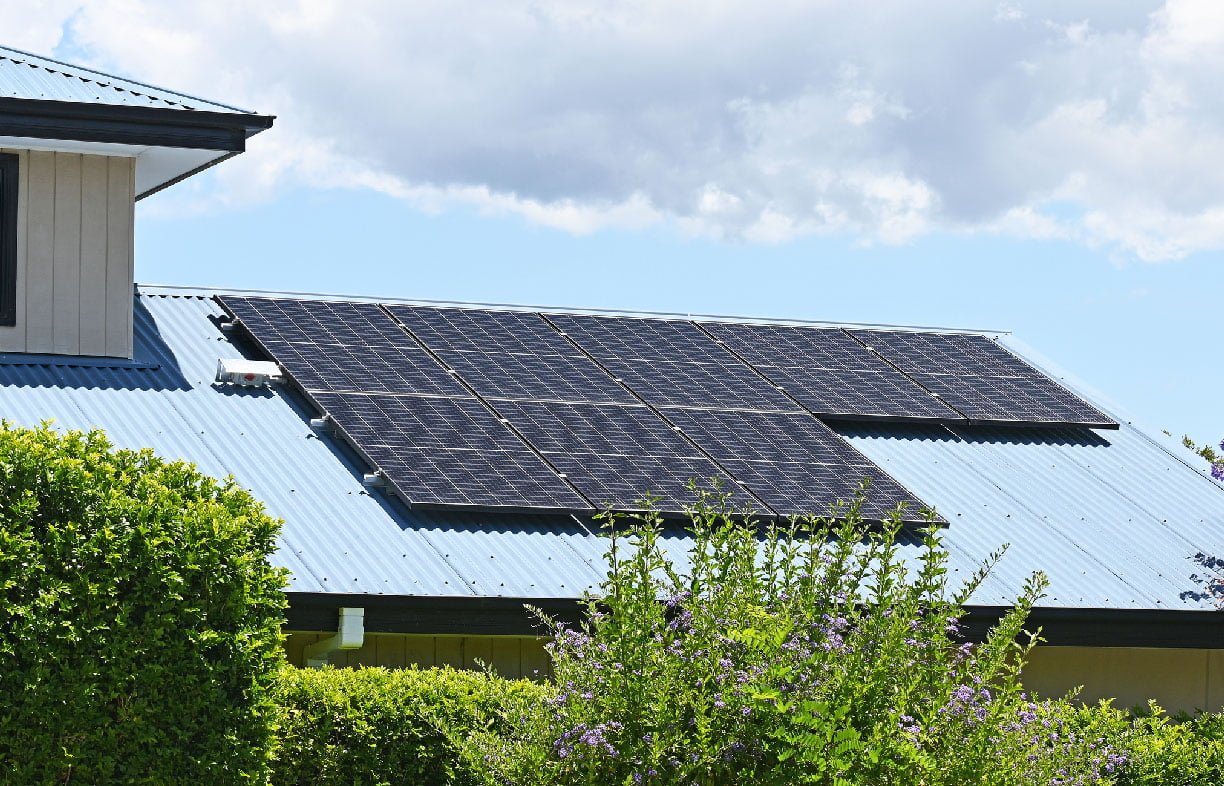 All-electric
All-electric
Direct PV solar hot water buyers guide
Solar hot water can dramatically reduce your water heating costs, but what if your house isn’t suitable for a conventional solar water heater? There is an alternative that can be used almost anywhere you have solar access, as Lance Turner explains.
Read more All-electric
All-electric
Staying warm in winter: A buyers guide to heating
As autumn declines into another long winter, it seems an opportune time to revisit one of our most popular buyers guides: our essential guide to heating yourself and your home.
Read more Buyers guides
Buyers guides
Electric vehicles for newbies
In this Renew special feature find everything you want to know about electric vehicles: how they work, why they’re superior to internal combustion engine-driven cars—and, yes, whether you can tow with them.
Read more

